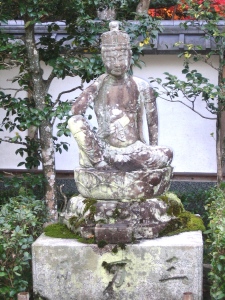The 4 Noble Truths: A Path to Happiness
The Buddha was called the “Happy One.” His capacity to truly appreciate life was strong and full because his home was the present moment and he could receive the aliveness and beauty in all forms of life and its manifestation. He truly understood the nature of reality; rejecting nothing and accepting everything. He cultivated a state of being that recognized what brings human happiness, called sukkha, the pleasant, happy moments. He also learned how to live in harmony with the myriad causes and conditions which life brings. His capacity for seeing life’s challenges and difficulties without backing away from them, denying them, or compensating for them, allowed him to live with what is. This was not a temporary happiness but a lasting happiness, not based on conditions. This was freedom.
 The Buddha recognized that there were certain universal conditions that were difficult for most people and he called this dukkha; unsatisfactoriness, unreliability, and stress. This he named the first Noble Truth. There was sickness, old age, death, loss, life’s changing conditions, called impermanence. His life’s work centered upon teaching others how to live with the causes and conditions life brings to us, living in the present, with acceptance. When we live without struggling against life there is ease, peace and happiness.
The Buddha recognized that there were certain universal conditions that were difficult for most people and he called this dukkha; unsatisfactoriness, unreliability, and stress. This he named the first Noble Truth. There was sickness, old age, death, loss, life’s changing conditions, called impermanence. His life’s work centered upon teaching others how to live with the causes and conditions life brings to us, living in the present, with acceptance. When we live without struggling against life there is ease, peace and happiness.
There is a cause for this stress and unhappiness and he called it clinging, craving or wanting. The second Noble Truth. It manifests as wanting what we do not have, the enjoyable pleasant things in life and pushing away what is uncomfortable, the unpleasant aspects of existence. It is the attachment to these temporary states that causes suffering. He taught that both pleasant and unpleasant states are impermanent; they change and do not stay. Yet, we try and control the uncontrollable to meet our needs, resisting life and this causes unhappiness. The Buddha invites us to give up or abandon this way of thinking and being by using our mindfulness to see clearly what is really going on. That pleasant and unpleasant are not really who we are, they are just passing conditions.
It is in the relinquishing of our attachment that we find freedom- what he called cessation. This is the Third Noble Truth. The habit of continually repeating the same afflictive emotions and negative mind states keep our way of thinking and perceiving fixated, obsessed and driven. When we recognize this and begin to let go in small ways of this pattern of endless wanting, we have a taste of relief, ease, and happiness. When we decide our primary intention is the wish to be free it becomes possible to dwell in cessation.
The willingness to work with this, the yearning inside us for a complete and satisfied way of living and being allows us to enter the Buddha’s roadmap for happiness: The Noble Eight-Fold Path. This is a complete path to fulfillment and meaning. The Path consists of
wise understanding, wise intention, wise speech, wise action, wise livelihood, wise effort, wise mindfulness, and wise concentration. It includes the Three Trainings which are: Ethics/Sila, Meditation/Samadhi, and Wisdom/Panna, from the Pali language.
